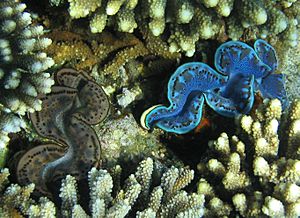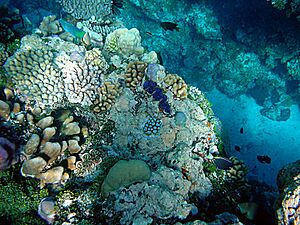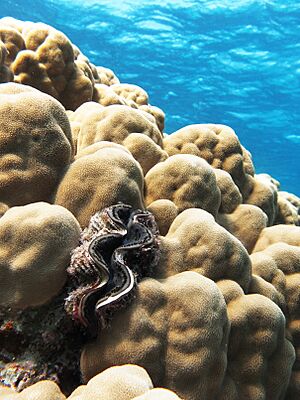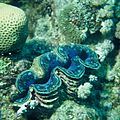Maxima clam facts for kids
Quick facts for kids Maxima clam |
|
|---|---|
 |
|
| Conservation status | |
| Scientific classification | |
| Genus: |
Tridacna
|
| Species: |
maxima
|
The maxima clam (Tridacna maxima), also called the small giant clam, is a type of clam found in the Indo-Pacific Ocean. Many people want them for their aquariums. They look a lot like the real giant clam with their amazing colors. But maximas stay a good size, usually no bigger than 20 centimetres (7.9 in) (about 8 inches) long.
Contents
About the Maxima Clam
Bivalves are sea creatures with two shells, like a clam. They pull water into their bodies to get oxygen using their gills. They also filter tiny algae from the water for food. The maxima clam is much smaller than the true giant clam (Tridacna gigas). It is less than one-third the size.
The Shell of the Maxima Clam
Adult maxima clams grow a large shell. This shell sticks to rocks or coral using strong threads called a byssus. These threads come out of a hole near the shell's hinge.
The Colorful Mantle
When the clam opens its shell, you can see its bright blue, green, or brown mantle. The mantle covers the edges of the shell, which have clear, bumpy lines. The beautiful colors of the small giant clam come from special cells. Scientists think these cells help protect the clam from strong sunlight. They might also help the algae inside the clam get more light for photosynthesis. Maxima clams make white colors by grouping red, blue, and green cells together.
Where Maxima Clams Live
The small giant clam lives in more places than any other giant clam species. You can find it in the oceans around East Africa, India, China, Australia, Southeast Asia, the Red Sea, and the Pacific islands.
These clams live on the surface of coral reefs or sand. Sometimes they are partly buried in coral. They need to be in sunny areas because they have a special partnership with tiny algae. These algae need sunlight to make energy for the clam.
Life Cycle and Habits
The small giant clam is a mollusc that stays in one place. It attaches itself to rocks or dead coral. It pulls water through its body to filter out tiny plants called phytoplankton for food. It also uses its gills to get oxygen from the water. However, it doesn't need to filter-feed as much as other clams. This is because it gets most of its food from tiny algae called zooxanthellae that live inside it. These algae make food using sunlight.
How Maxima Clams Grow
A maxima clam starts as a tiny fertilized egg. It hatches within 12 hours and becomes a free-swimming larva. This larva then grows into a more developed larva that can filter-feed. In the next stage, it grows a foot. This foot lets the larva swim and rest on the ocean floor. After about eight to ten days, the larva changes into a young clam. At this point, it can get the zooxanthellae algae and start its special partnership.
Reproduction of Maxima Clams
Young clams become male after two or three years. As they grow larger, around 15 centimeters (6 inches), they become hermaphrodites. This means they are both male and female. Reproduction is triggered by the moon's cycle, the time of day, and if there are other eggs and sperm in the water. Hermaphrodite clams release their sperm first, and then later release their eggs. This helps make sure they don't fertilize themselves.
Images for kids
This article incorporates text from the ARKive fact-file "Maxima clam" under the Creative Commons Attribution-ShareAlike 3.0 Unported License and the GFDL.
- species name is missing
See also
 In Spanish: Tridacna maxima para niños
In Spanish: Tridacna maxima para niños









